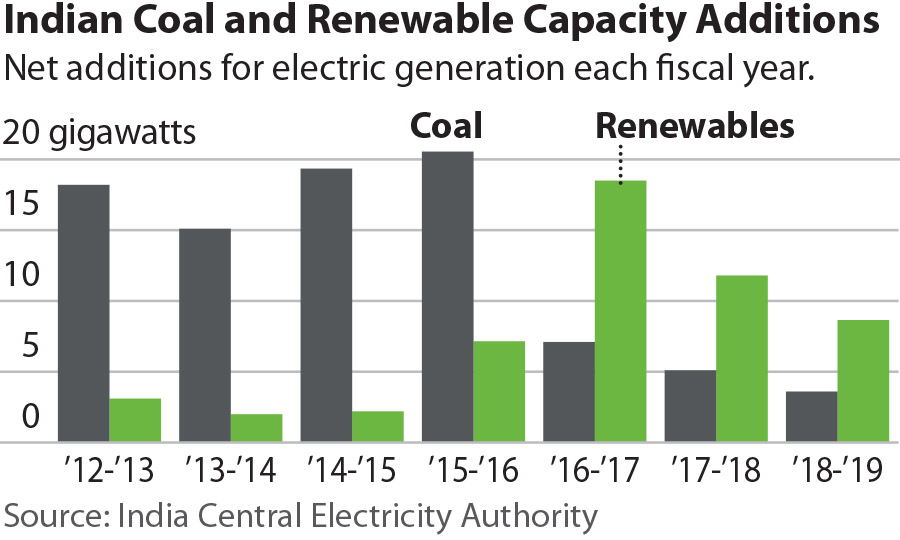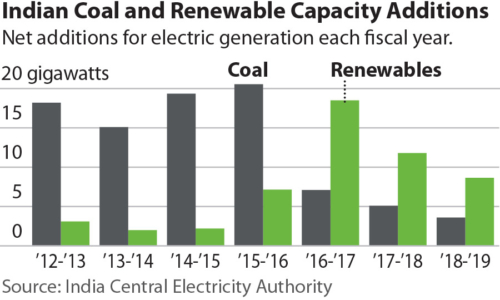IEEFA report: Major water shortages and other stressors raise risks for India’s coal sector

 September 4, 2019 (IEEFA) ‒ India’s coal-fired energy sector is facing increasing pressure due to generator over-capacity, water shortages and the rise of competition from low-cost renewables and hydro power, according to a report released today by the Institute for Energy Economics and Financial Analysis (IEEFA) and the Applied Economics Clinic (AEC).
September 4, 2019 (IEEFA) ‒ India’s coal-fired energy sector is facing increasing pressure due to generator over-capacity, water shortages and the rise of competition from low-cost renewables and hydro power, according to a report released today by the Institute for Energy Economics and Financial Analysis (IEEFA) and the Applied Economics Clinic (AEC).
The report, Risks Growing for India’s Coal Sector, provides an overview of the ongoing challenges facing India’s coal-fired generators due to changes in the energy sector, fluctuations in water supply and stranded-asset as well as other risks.
Water shortages are one of the major stressors on India’s thermal coal industry
“The energy landscape has changed dramatically in recent years and there are increasing stressors, particularly on the thermal coal sector, that require urgent attention, water being one of the most prominent,” said David Schlissel, co-author and IEEFA’s director of resource planning analysis.
The report details three major challenges that are expected to only intensify in the years ahead, namely:
- Over-building of coal-fired capacity. The boom in coal plant construction during the early 2010s has resulted in significant over-capacity. The amount of installed coal-fired capacity in India is now 20 percent higher than the country’s peak demand level and fully 50 gigawatts (GW) above average demand levels.
- Declining water supplies. Groundwater levels across India are in decline. Since 2012, both total annual rainfall and monsoon rainfall have generally been below normal levels ‒ a major concern for coal generation, which requires substantial amounts of water for steam production and cooling.
- Increasing competition from renewables (wind and solar) and from hydropower plants, particularly during the monsoon season. These forms of energy have a great advantage during the monsoon season, when coal generation dips while wind and hydro generation peak.
“India’s overbuilt coal power capacity has left two related problems. First, utilization rates have fallen, impairing the economic competitiveness of coal plants because they must spread their costs over a diminishing number of kilowatt-hours,” said Bryndis Woods, researcher at the Applied Economics Clinic (AEC) and co-author of the report. “Second, over-capacity has burdened the system as a whole since the plants’ capital costs still need covering even if their electric output is not needed.”
Climate change is expected to exacerbate the effects of both flooding and drought
Ongoing water shortage problems in India forced 61 plant shutdowns from 2013-2017, resulting in roughly 17,000 gigawatt-hours of lost generation (and revenue). Water-related problems are projected to worsen as the impacts of climate change continue to exacerbate the duration and severity of both flooding and drought.
About 41GW of India’s installed thermal capacity is located in drought-affected areas, with about 37GW located in “extreme drought” areas, according to the report.
ANOTHER MAIN FACTOR IN THE ENERGY SHIFT IS THE WAVE OF NEW RENEWABLE CAPACITY PLANNED FOR INDIA, 275GW by 2027 and as much as 500GW by 2030. Prices for onshore and offshore wind and solar are expected to continue declining while prices for coal-fired generation are likely to rise. All solar and wind auction prices in India since June 2018 have come in below 3.29 Rs/kWh, less than the average FY 2018-19 price of coal-fired electricity (3.46 Rs/kWh, equal to US$0.045/kWh) from NTPC—the state-run utility that operates 53GW of coal-fired capacity.
“The economics already favor renewables, and we expect the cost disparity between renewables and coal to widen as time goes on,” said Schlissel.
The report concludes with four policy recommendations:
- India should adopt a policy of no net new coal-fired power generation beyond what is already under construction.
- Plants under construction should be reviewed for possible cancellation.
- An economic assessment should be conducted of the nation’s oldest coal-fired power plants to determine their financial viability, including the cost of retrofitting with pollution controls. A phased, end-of-life closure plan needs to be prepared and implemented.
- Coal capacity in the most drought-stricken areas must be addressed as a priority. This capacity should be replaced with low-cost renewable resources (wind and solar). Accelerated investment in interstate grid transmission capacity expansion and modernization is required to build national grid reliability and accommodate low-cost but variable renewable energy.
“With a growing population and economy, India needs to pay greater attention to its water resource problems in order to guarantee long-term supply availability for all,” said Woods.
Authors
David Schlissel ([email protected]) is IEEFA’s director of resource planning analysis.
Bryndis Woods ([email protected]) is a researcher at the Applied Economics Clinic (AEC).
Vibhuti Garg ([email protected]) is an IEEFA energy economist based in India.
Full Report: Risks Growing for India’s Coal Sector
Media Contacts
Vivienne Heston ([email protected]) tel: +1 (914) 439-8921
About IEEFA
The Institute for Energy Economics and Financial Analysis (IEEFA) conducts global research and analyses on financial and economic issues related to energy and the environment. The Institute’s mission is to accelerate the transition to a diverse, sustainable and profitable energy economy. www.ieefa.org
About the Applied Economics Clinic (AEC)
The AEC is an independent, 501(c)(3) non-profit consulting group that provides expert testimony, analysis, modelling, policy briefs, and reports for public interest groups on the topics of energy, environment, consumer protection, and equity, while providing on-the-job training to a new generation of technical experts. www.aeclinic.org












